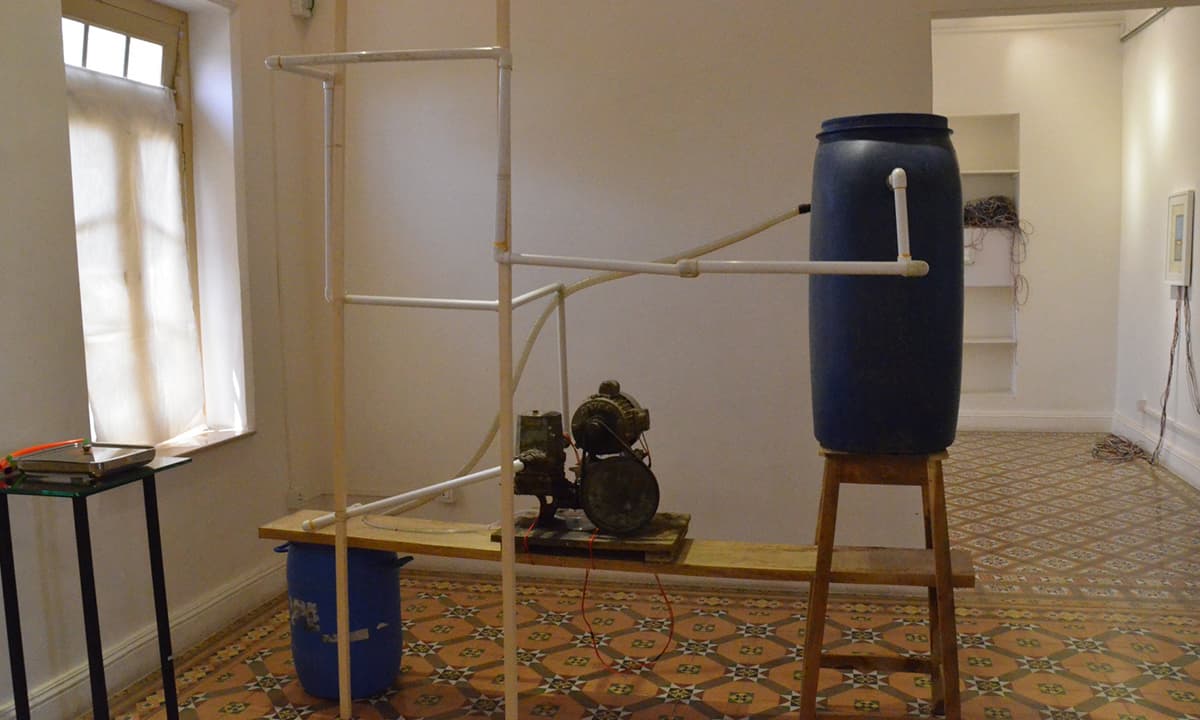
Electricity, water and gas are three resources critical to every household in Pakistan. Their inconsistent supply across different parts of Karachi is a telling outcome of the city’s unequal social hierarchy. Wealth determines distribution while wasteful usage and lack of sustainable service policies also pose a problem.
As part of the 10th Taaza Tareen Residency, the Vasl Artists’ Association highlighted the risks of depleting resources through an innovative exhibition at The Dawood Foundation House (TDF Ghar) from April 7 – 12. Artists-in-residence, Maryam Arslan, Mujtaba Asif, Rahman Zada and Sabeen Ahsan, and writer-in-residence Arsalan Isa, exhibited their work and explored how electricity, water and gas affect human existence.
Maryam Arslan, famous for her whimsical art and oil paintings, is a BFA graduate from the Indus Valley School of Arts and Architecture. After her MA in Art and Design Studies from Beaconhouse National University, Lahore, she quickly became one of Vasl’s more well-known artists in residence. She uses her skill with thick oil paint and intense brush work to represent scrumptious narratives: she entices viewers with a bright and colourful portrayal of edible treats — a brimming cup of tea, swirled strokes of vanilla cake, a canvas of meetha paan and a bowl of channa and puri. Her attention to detail is evident in her portrayal of temptations that exist to distract the viewer, until she brings them back to reality, by stating in her artist’s note the impossibility of creating these treats without electricity, water and gas.

Rahman Zada presents a different take on these resources. An alumnus of the National College of Arts, Lahore, Zada strongly believes in the power of connections. His work has a history of showcasing human communication through technical means such as electricity and wires. In this exhibition, Zada interpets the ease of interaction through the invisible connections of technology; however, he also perceives this transfer of human communication from physical to battery-powered devices as a conscious form of breaking social ties and creating distance.
Another focus of his work is exploring how human actions affect natural surroundings. He explains that the aim of his work is to make the “invisible visible”. Burnt out sockets and an empty pipe suggesting invisible electrical waves are also part of his exhibit, illustrating how lack of electricity can disrupt daily life.
Mujtaba Asif also addresses such disruption and repercussion. To inform his previous and current work, the artist travelled to various Karachi neighbourhoods to better understand the unequal distribution of power, wealth, electricity, water and gas between the privileged and the disempowered.
Asif’s display of torn-out book pages hanging on clothes lines is a comment on how, in a process of societal negligence, human rights are reduced to laws found only in forgotten books. The details of the ruined pages (water stains, crumbling pages) reflect his belief that aside from humans, multiple living organisms are also the victims of the overuse and abuse of these three resources. The pages’ existence is not possible without tree bark and the water stains on it show that due to overuse of paper and resources such as water, the natural world is nearing the end of its life. As he explains in his note, his enduring hope for a better future is the only thing he can hang on to, and perhaps he is representing this delicate hope by hanging the worn pages on the clothes line.

The last artist, Sabeen Ahsan, emphasises the fluidity of water in a display of paintings. Her work looks at water on a smaller, more literal scale. Using dark hues of blue and black on canvas, she depicts the sensory experience of water as it flows and drips. A recent graduate of the National College of Arts, Ahsan incorporates gouache drawings, photography and mixed media in her work, using abstract forms to explore space, movement and texture. In her exhibit, these forms whirl, twist and move into each other.
The exhibition also houses a collection of poetry and prose in English, and witty one-liners in Urdu. The poem Darkness, printed first on white paper and then alongside it on black paper, shows the results of the presence and absence of electricity, gas and water — the smudged, fading words on the page, and the unreadable words on the black paper, hint at a life without electricity.
For a city such as Karachi where electricity, gas, water and art struggle to exist, Vasl’s creative display in the popular and picturesque TDF Ghar is a welcome addition to the city’s art scene. In an exhibit that seems to be simple, Vasl’s artists ask us to rethink or at least question our use of the ever-scarce resources of bijli, pani and gas.
The writer is a staffer at the Herald.










